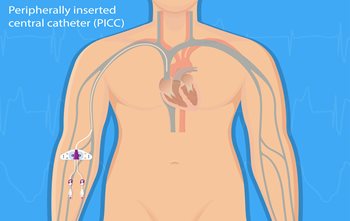Sign in or register for an account.

It’s All About PICCs
This CNE course is designed for nurses caring for the patient with a peripherally inserted central catheter or PICC. The use of this particular type of central venous access device is different in some ways from other types of central lines. Therefore, education related specifically to the PICC is crucial to the safe and effective use of this type of device.
In early 2024, the Infusion Nurses Society (INS), recognized as the global authority in infusion therapy, released the updated Infusion Therapy Standards of Practice. The INS sets the accepted standards for infusion therapy practice for all healthcare settings. This course is based on the current best practices as defined by the Infusion Nursing Society and other governing agencies such as the CDC, and FDA.
This course contains the skill check-off lists for the skills associated with providing infusion therapy via a PICC, these skills are completed with a preceptor. These competency requirements are obtained and maintained through the nurse’s employer, facility or institution, via their designated preceptor. Each State Board of Nursing may have varying positions on the role of the LPN/LVN in the administration of infusion therapy via central lines, and removal of PICCs. Each nurse will need to verify the rules within their own state's scope of practice.
In early 2024, the Infusion Nurses Society (INS), recognized as the global authority in infusion therapy, released the updated Infusion Therapy Standards of Practice. The INS sets the accepted standards for infusion therapy practice for all healthcare settings. This course is based on the current best practices as defined by the Infusion Nursing Society and other governing agencies such as the CDC, and FDA.
This course contains the skill check-off lists for the skills associated with providing infusion therapy via a PICC, these skills are completed with a preceptor. These competency requirements are obtained and maintained through the nurse’s employer, facility or institution, via their designated preceptor. Each State Board of Nursing may have varying positions on the role of the LPN/LVN in the administration of infusion therapy via central lines, and removal of PICCs. Each nurse will need to verify the rules within their own state's scope of practice.
Questions? Check out our FAQs page and How Online IV Certification Works!
Objectives
Upon completion of this course, the participant will be able to:
- Distinguish a peripherally inserted central catheter (PICC) from other types of central venous access devices.
- Describe the procedure for each maintenance task of PICC care.
- State at least 3 potential PICC complications, prevention and treatment.
Curriculum
Chapter 1: PICC Description
- CVAD definitions and terminology used
- Indications and Contraindications
- Anatomy and Physiology
- Tip placement
Chapter 2: Assessment and Preparations for PICC
- Assessment Criteria for Insertion of a PICC
- Preparations for PICC insertion
- Education of Patient and Caregiver
Chapter 3: Infusion Product Review and Maintenance Guidelines
- Needleless Connectors
- Passive Disinfection Caps
- Filtration
- CVAD Stabilization
- Site Protection
- Flushing
- Locking
- Pediatrics
- Antimicrobial locking solutions
- SASH
- Assessment/Tracing
- Dressing Changes
- Administration Set Change
- Primary and Secondary Continuous Infusion
- Primary intermittent infusion
- Parenteral Nutrition
- Blood/Blood Component
- Blood Sampling from a PICC
Chapter 4: PICC Care Procedure and Videos
- PICC Dressing Change
- Central Venous Catheter Needleless Access Device Change
- Central Venous Catheter Flushing and Locking
- Blood Sampling from a CVAD- Discard Method
- PICC Occlusion Clearing
Chapter 5: Complications
- Phlebitis
- Chemical
- Mechanical
- Bacterial
- Central Vascular Access Device Occlusion
- Thrombotic Occlusion
- Mechanical Occlusion
- Medication/Lipid Precipitate Occlusion
- Bleeding/Hematomas
- Infiltration/Extravasation
- Site Infection/Catheter Related Bloodstream Infection (CRBSI) or Septicemia
- Catheter Damage/Embolism
- Venous Air Embolism
- Tip Malposition
- Medical Adhesive Skin Related Injury or MARSI
- Nerve Injury
Chapter 6: Documentation, Discontinuation of Therapy
- Discontinuation of therapy
- PICC removal
Chapter 7: References
- California Bill 241
- Implicit Bias in Healthcare
- What is Implicit Bias?
- Implications of Implicit Bias in Healthcare
- How to Reduce Implicit Bias
Price: $36.00
Contact Hours: 3

Course Author

Capra Garrison
Capra Garrison, Registered Nurse, has more than 33 years of experience in infusion therapy and the instruction of licensed nurses in infusion therapy continuing education. Her experience comes from multiple infusion settings: acute care, ambulatory infusion centers, home infusion, long term care continuing education provider, and long term care pharmacy quality assurance consultant. Capra has an avid interest in holistic healing, nutrition, herbs, and alternative therapies for the treatment of disease in humans as well as animals.
Read Full Bio
Course Accreditation
See our Accreditation Statements page to view our accreditation information.